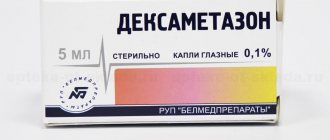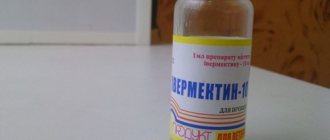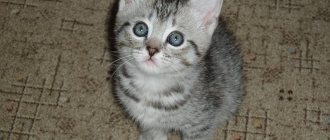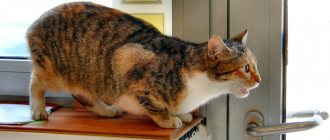First you need to earn the trust of your four-legged friend. From the first days a kitten (or an adult cat) appears in the house, you need to talk to it affectionately, control your behavior - you cannot frighten or force the cat to do anything, but you must immediately establish house rules, which include hygiene procedures, and stick to them.
If the pet was purchased from a breeder, it is worth asking what the kitten was trained to do. It is quite possible that your pet already knows what maintaining eye hygiene means and knows how to behave correctly.
An examination is always carried out before the procedure. Goodies are prepared in advance for encouragement. You can also use a favorite toy to reward efforts. You need to evaluate your pet's mood. If the cat is tired, or, conversely, overexcited, you should not burden it with such manipulations; it is better to wait for a more appropriate moment.
Is it possible and how to rinse a cat’s nose with saline solution?
If the cat is ready, you need to praise it and place it comfortably on the table or pick it up. First, they gently touch the muzzle, stroking and holding the head in one position so that the cat gets used to it. Be sure to speak to your pet in a friendly tone. Then they pull back the lower eyelid, inspecting the mucous membranes and praise again. An eye examination does not take much time and is quite easy. After this, you can begin cleaning the eyes and fur around them.
Do kittens or adult animals need to clean their eyes if there is no discharge?
To cleanse the eyes of dust and tiny specks, the cat's body produces a small amount of clear liquid. As a rule, pets completely remove it along with dirt on their own, but in the morning its volume increases, so it can accumulate in the corners of the eyes. In this case, you need to clean the animal's eyes with a cotton pad dipped in water. The kitten's discharge is removed by the mother cat until he learns to wash himself. If a small pet does not take good care of its hygiene, of course, you need to help it.
Medicines
In practice, there are a lot of remedies that will help get rid of foreign deposits in the eyes. The range varies from tea infusion to pharmaceutical drops. But before that, let’s define the nature of the discharge and the reasons that cause it:
- Thick yellowish pus is an infectious infection with microorganisms or fungi.
- Colorless discharge with a watery consistency is more likely to cause eye injury or food allergies, etc.
- Discolored discharge that dries out and turns brown or gray indicates that particulate matter has entered the eye. For example, dust.
Many people are interested in whether it is possible to wash a kitten’s eyes with tea? The answer is yes. There are many budget, if not folk, remedies that will help keep your cat's eyes normal.
ATTENTION! You should practice hygiene only when necessary. Prevention without obvious discharge is fraught with damage to the mucous membrane. Especially for a kitten.
Let's move on to specific drugs that will help save a cat's eyes if they fester:
- Furacilin. A popular, effective and most importantly inexpensive drug. Of the nuances, it is worth noting that furatsilin should be in a concentration of 0.02%. A higher concentration will cause irreparable damage to the eye, causing a burn. It is permissible to take one tablet and dissolve it in warm water. But there is a high probability that your concentration will be wrong. Therefore, it is preferable to buy it in a store.
- Chlorhexidine. Alternative to Furacilin. The main thing is also to observe the percentage ratio (0.01%) and carefully read the instructions.
- Boric acid. It is used for severe inflammation of the eye and large accumulations of purulent discharge. One teaspoon (5 grams) per 200 ml of boiled water is enough. Do not use for bleeding.
- Saline solution To avoid burns to the mucous membrane, the concentration of saline solution should be 0.9%.
- Potassium permanganate. Available remedy. Private guest of a home pharmacy. A slightly pink solution should be prepared. A prerequisite is the complete dissolution of potassium permanganate crystals, so as not to harm the pet’s eye.
- Herbal decoctions and black tea. A relatively inexpensive, but natural remedy for the treatment of purulent and other discharge. Chamomile, St. John's wort, calendula are often used.. Take 1-2 teaspoons and dissolve in about 200 ml of water. Let the broth stand in boiling water for 10-15 minutes. Then filter the liquid through several layers of gauze.
- You can use aloe juice. Grind 1-2 leaves of the plant thoroughly. Strain the broth and rinse your eyes 2 times a day. An infusion of yarrow is also effective. Pour 10 grams of the plant into 250 ml of boiling water and leave for at least half an hour. Rinse the inflamed areas at least 4 times a day.
- An infusion of celandine is used against redness and excessive discharge of pus. Chop 4-5 leaves and pour 100 ml of boiling water. Leave for 15-20 minutes and wet your eyes. Celandine perfectly eliminates pain. The black tea solution must be infused for 10-12 hours.
- You cannot use tea from bags, only natural leaf tea. Linden tea helps well in this situation. Pour 5 grams of the plant into 100 ml of boiling water. Thoroughly filter and rinse your pet's eyes. Repeat the procedure 2-3 times a day.
- Saline solution. Place one teaspoon of salt per liter of water. The solution is thoroughly mixed and boiled. Cool to room temperature. Saline solution is effective for all cases except eye problems caused by an allergic reaction.
- Boiled water. If you don’t have any of the listed drugs or solutions at home, you can get by with regular boiled water. But it is used for routine eye cleaning and has no medicinal functions.
All solutions must be warm. Excessive cooling is not allowed. Separately, we note the drugs that are used to wipe the eyes of kittens.
Kids require special treatment. If you have the slightest doubt, it is better to seek help from a veterinarian:
- Drops "Diamond eyes". The basis of the drug is the same chlorhexidine. Additional substances C chloride and tuarine have an excellent healing effect.
- "Leopard". The drops contain the mentioned furatsilin. Excellent fight against microbes. It contains novocaine, which has an excellent analgesic effect.
- "Iris". It is made on the basis of the antibiotic gentamicin. Often used for excessive tearing in a kitten and increased sensitivity of the eyes. Before use, you need to place the kitten in a dark room for some time. But the owner must be nearby so that the baby is not afraid.
To treat a fairly common eye disease - conjunctivitis - chloramphenicol or ciprofloxacin is used. Both drugs are based on antibiotics. Used in situations where the kitten squints or has difficulty opening its eyes (does not apply to the first weeks after birth).
ATTENTION! Small accumulations near the eyes after sleep are a common occurrence not only for cats, but also for people. There is no need to worry about this. Usually the cat gets rid of them after washing herself. If you wish, you can help your pet using cotton pads.
How to remove dry discharge in the corners of the eyes?
Eyes should be cleaned only with tampons and cotton pads. Dry discharge is removed with water, special drops (Diamond Eyes), lotions (Canina Augen Pflegelotion) and sanitary napkins (Mr.Gee, Gamma, Let's go for a walk!), which are convenient to use if something gets into the eye. The use of these products allows you to gently remove secretions without causing irritation. Medicinal and traditional antiseptics should not be used for this purpose; they should be prescribed by a veterinarian in the presence of pathological symptoms such as lacrimation, swelling of the eyelids, pus, etc.
How to clean your eyes
There are a number of products approved for safe and relatively safe contact with the organs of vision. Products can be purchased at pharmacies (veterinary or human), and also prepared at home.
Pharmacy products
Furacilin solution 0.02%
aqueous solution 1:5000, price 50-63 rub.
Purchase a ready-made solution at a pharmacy. Exceeding the concentration of furatsilin can cause additional irritation of damaged eyes, including corneal burns. It is very difficult to independently calculate the dosage for the required small volume of solution, because For 5 liters of water only 1 g of furatsilin is required.
Boric acid solution
price 10-21 rub.
Thoroughly dissolve 5 g (or 1 teaspoon) of purified (pharmacy) powder in 200 ml of cooled boiled or distilled water. Do not wash the eyes with boric acid if there are wounds with a violation of the integrity of the skin and bleeding.
Saline solution 0.9%
sterile, price 18-25 rub.
It is best to purchase it ready-made at the pharmacy, because... at home, you can make a mistake with the proportions, which can lead to burns to the mucous membranes of the eyes.
Chlorhexidine solution 0.01%
price 8-12 rub.
It can be purchased at a pharmacy or diluted independently at home from 0.05% chlorhexidine, but strictly observing the proportions. A high concentration of this solution can cause harm to the animal in the form of local irritant reactions or burns to the mucous membrane. To obtain a 0.01% solution: 4 ml of 0.05% chlorhexidine is taken into a 20 cc syringe and brought to 20 ml with a 0.9% pharmaceutical sterile saline solution (i.e. +16 ml).
Potassium permanganate solution (potassium permanganate)
1:5000, price 30-45 rub.
The solution should be slightly pink in color without the presence of undissolved crystals. Otherwise, there is a high risk of chemical burns.
Drops "Diamond eyes"
price 70-90 rub.
A veterinary drug that contains taurine, chlorhexidine and succinic acid in proportions that are safe for animals. They are used not only to treat ophthalmological diseases of cats, but also to wash the eyes.
Home Remedies
- Herbal decoctions. To wash the eyes, decoctions of chamomile, calendula, St. John's wort or hyssop herb are most often used. The decoctions are not strong. 1-2 tsp. any herb is poured with boiling water in a volume of 200 ml and infused for 7-10 minutes. It is carefully filtered through several layers of gauze to prevent additional contamination of the eyes with specks, cooled and used.
- Black tea. It is a mistaken belief that the eyes should be washed with freshly brewed tea! To wash the eyes, take “sleeping” tea, i.e. brewed from yesterday or left for at least 10-12 hours. Normal strength, no sugar. Only tea prepared from leaf tea leaves, not bagged tea, is suitable for use. Tea bags may contain all sorts of food additives that can become an additional source of allergic reactions.
- Clean boiled water.
Absolutely all solutions should be slightly warm or not lower than room temperature. Solutions should provide relief and not cause discomfort by being too hot or too cold.
What to do if your cat has pus in her eyes?
If you notice pus in your pet’s eyes, you should not panic and frantically go through antiseptic medications at your home pharmacy, but show it to the veterinarian. Often it indicates serious illness. In this case, the animal requires complex treatment, including not only the use of eye drops, but also oral administration of veterinary medications and a special diet. What products can be used to wash eyes at home?
Why do cats' eyes fester?
Purulent discharge is a symptom of diseases such as bacterial conjunctivitis, keratitis, blepharitis, calcivirosis, panleukopenia, viral leukemia, helminthic infestation, etc. and is a consequence of injury, aggressive action of pathogenic flora and parasites in the body. A sick animal also experiences symptoms such as fever, nasal discharge, sneezing, weight loss, vomiting and diarrhea, the presence of foreign matter in the feces and urine - mucus, blood, helminth eggs, etc.
Persian cat
Brachycephalic breeds (Persian, Himalayan, British, Scottish and Exotic Shorthair cats) are predisposed to excessive eye discharge. These animals have slightly flattened muzzles and narrow nasolacrimal ducts, which prevents the normal outflow of tear fluid. Delayed secretion increases the risk of developing a chronic inflammatory process and provokes the formation of pathological fluid.
How to wash your eyes?
Compositions used to remove purulent exudate from the eyes are divided into 3 categories: pharmaceutical antiseptics, special drops and folk remedies. Regardless of the reason for the appearance of pus, the selection of the drug should be carried out by a veterinarian, since this symptom indicates the advanced stage of the disease and requires complex treatment, where rinsing is one of the components of therapy.
Ready-made preparations (solution of potassium permanganate, furatsilin, Chlorhexidine, etc.)
Before using special drops and ointments, you need to clean your eyes from purulent exudate, crusts and dust using the following antiseptics:
- Furacilin. Crush and dissolve 2 tablets in a glass of warm boiled water. The product has an average antimicrobial effect.
- Boric acid powder. Stir 2 tsp. means without a slide in 0.5 glasses of water. Do not use this drug if there is bleeding.
- Potassium permanganate. Dissolve several crystals of potassium permanganate in water. A highly concentrated solution causes a burn to the mucous membranes of the eyes. Normally it should be transparent and slightly pink.
- Chlorhexidine. To prevent side effects (tearing, redness, etc.), you need to use the drug with a concentration of 0.05%. You need to fill the syringe with 4 ml of Chlorhexidine and 16 ml of saline solution (0.9%). Even a kitten's eyes can be cleaned with a weak solution of Chlorhexidine.
Folk remedies
To prevent your eyes from festering, you can wipe them with the following folk remedies:
- Black tea. The composition is prepared from large-leaf tea leaves without sugar and infused for at least 10 hours. Strong tea does not cause side effects, so even a kitten can wash its eyes with it.
- Lime tea. You need to pour 1 tsp. linden flowers 0.5 cups of boiling water and let it brew for 40–45 minutes. The plant is very allergenic, so it is used only as prescribed by a doctor and with full confidence that the pet is not allergic to pollen.
- A decoction of string, chamomile or calendula. You need to pour 2 tbsp of boiling water into a glass. l. spoons of any plant and leave until cool. These components have not only an antiseptic, but also a soothing effect on sore eyes.
How to wash a cat's eyes: algorithm of actions
It is necessary in advance, so that the cat does not see or worry, to prepare drops, antiseptic, tampons or cotton pads in another room. To prevent secondary infection, the procedure must be carried out with gloves. It is best to do this together, as the animal will struggle. To wash your cat's eyes, you need:
Features of eye care depending on the cat breed
Some pets with short muzzles are prone to eye diseases. Also, representatives of such breeds have a shortened tear duct, which provokes the constant secretion of tears. Because of this, Persian cats, exotics, British and similar breeds always have wet tracks on their cheeks. In white cats, such discharge often darkens and turns brown.
What is a mat cutter for cats and how to use it
Such pets need to have their eyes examined more often, rinsed, removed dirty marks, and dried their fur with clean, dry wipes. If there are folds on the face, they are treated with talcum powder.
Prevention of purulent eye inflammation in cats
It is necessary to regularly examine the cat's eyes for excess discharge, injuries, stuck debris, etc. Minor wounds can be treated with Chlorhexidine or furatsilin solution; in severe cases, you need to contact a veterinarian. It is necessary to undergo veterinary examinations 2 times a year, carry out antiparasitic treatment and receive vaccinations according to the schedule. To strengthen the immune system, you need to provide your pet with a balanced diet and protect it from hypothermia and stress. During the walk, you need to prevent his contacts with stray animals and climbing in the bushes.
It should be understood that eye washing cannot be carried out for prophylactic purposes. The cat will develop irritation and man-made conjunctivitis. Treatment should be carried out when excessive tearfulness occurs, and there are no additional pathological signs.
You should not wash your kitten's eyes. Its tears protect the cornea and mucous membrane of the eyelid from dust, debris, and microbes. And if your baby has other symptoms, you need to show him to a doctor. Chlamydia, cat flu, and other dangerous diseases begin with harmless tearfulness.
Conjunctivitis is a symptom of many infectious diseases. At first, inflammation of the mucous membrane is characterized by clear discharge. Then the exudate thickens, becomes mucous and even purulent.
The discharge dries out and crusts form. The veterinarian prescribes eye drops containing antibiotics and anti-inflammatory substances. But, to cleanse the conjunctival sac from crusts and exudate, it is necessary to do a preliminary rinse.
Indications and contraindications for use
The medicine is a clear solution and is also available in the form of a spray for external use (or vaginal suppositories). Its trade name "Chlorhexidine" completely coincides with the active substance. Due to the fact that it leads to the death of pathogenic bacteria and other dangerous microorganisms, the indications for use are quite extensive :
- treatment of wounds, abrasions, burns;
- thrush;
- fungal infections;
- cervical erosion;
- inflammation of the oral cavity (stomatitis, gingivitis of various origins, periodontitis, etc.);
- Chlorhexidine is also used for the prevention of various sexually transmitted pathologies (chlamydia, gonorrhea, etc.).
© shutterstock
Basically, Chlorhexidine does not give any side effects, so it can be used topically and externally when treating cats. However, in some cases, a rash, itching may appear, and dermatitis may worsen. Then treatment should be stopped immediately and contact a veterinarian for advice.
How to wash a cat's eyes at home
It must be admitted that medications work more effectively than folk remedies, however, when damage to the organs of vision is insignificant, improvised means can be used for rinsing. Solutions should not be prepared at home.
Medical and veterinary pharmacies have a wide selection of medications. You should pay attention to how many times a day you should use medications and choose the best option.
The washing procedure must be carried out with cleanly washed hands, preferably with gloves, so as not to infect the pet.
After treatment, hands are washed again so that the cat’s eyes do not spread the infection into their own. The use of cotton pads is dangerous; fibers remain on the cornea. It is better to use a gauze swab.
Pharmaceutical rinses
The following cleaning agents are in demand:
- Diamond eyes contain the antiseptic chlorhexidine, an energy metabolism activator, succinic acid, and taurine, which increases visual acuity.
- Ophthalmosan - the same as Diamond Eyes, but without taurine. The drug is used to wash the organs of vision in case of mild lacrimation and to prepare the eye for the treatment of purulent conjunctivitis.
- Anandin eye drops are an immunomodulator that can be used for rinsing or treatment.
- Maxidin 0.15 - immunomodulating eye drops. Increases the body's resistance to viruses and microbes.
- Furacilin - you need to purchase a 0.02% solution at a medical pharmacy. You should not make the medicine at home.
- Boric acid.
- Chlorhexidine 0,01%.
Folk remedies for washing
A responsible owner of a purebred cat has a first aid kit containing selected medications to help his pet. But a purebred cat is also a beloved creature, and owners have to use what is at hand. The simplest thing is to wash your eyes with tea leaves. However, only loose leaf tea without additives is suitable.
If you don’t have tea, you will have to prepare a decoction of chamomile, calendula or St. John’s wort.
Signs of eye disease in cats
- Excessive tearfulness.
- Redness of the cornea.
- Formed hard crusts.
- Purulent discharge from the eyes.
- Cloudiness of the cornea.
These and other signs should alert any owner and serve as a reason to contact the nearest veterinary clinic for a qualified examination and prescribe the correct treatment for the diagnosis. However, in order to prevent ophthalmic problems in your pets, you need to carry out home prevention.
How to wipe a cat's eyes at home? Is it possible to use chlorhexidine?
Eye problems are considered to be quite common in cats. The development of pathologies of the visual organs is often the cause of infectious diseases or foreign bodies entering the eyes. After detecting the first symptoms of blurred vision, suppuration and redness of the pupils, you must immediately rinse the cat’s eyes at home or seek help from a veterinarian.
Clear and grayish discharge from the eyes is considered normal among healthy cats and kittens. In this case, it is enough to sometimes rinse your pet’s eyes with boiled water or chamomile decoction. In some situations, the animal can observe the process of suppuration or the release of excess fluid, which indicates the presence of an inflammatory process.
The following are the reasons for excessive secretion:
- the presence of a bacterial or viral infection, pathogenic fungi or parasites in the body;
- mechanical injury or bruise;
- ingress of a foreign object of insignificant size;
- an allergic reaction of the body to household chemicals, medications or plants.
In almost all situations, you can notice not only the release of fluid, but also the formation of pus. The presence of such symptoms leads to a lack of appetite, the eyes begin to itch, and the cat itself tries to hide in a secluded place. This condition requires specialist intervention.
A cat's eyes secrete a clear fluid that acts as a lubricant. Such secretions soften the friction between the inner surface of the eyelid and the cornea, which avoids injury due to dust and other foreign bodies. As a result, every morning a dark crust forms near the cat’s eye, which is not suppuration, but a natural discharge.
Typically, pus-filled eyes or excessive tear production is a concern for pet owners. According to certain factors, the reason for such a deviation can be determined:
- Yellowish or clear tears may cause dirt, dust, or other foreign bodies to get into the eyes and cause irritation;
- a common cold can cause irritation;
- redness in the affected area indicates that the cat may have accidentally damaged the cornea;
- If a pet constantly covers its eye with its paw, then it is quite possible that there is an infectious pathology.
Pet owners should consider purchasing eye rinses in advance, even if the cat is healthy. After all, such a procedure is a mandatory element of animal care.
You can wash your cat’s eyes yourself using special folk remedies that can be prepared quickly and without any special financial costs:
- Dissolve boric acid powder in an amount of 5 g in 250 ml of boiled water;
- brew 6 g of dried linden in 0.5 liters of boiling water;
- pour 5 g of pharmaceutical elderberry into 100 ml of boiling water;
- Pour several fresh celandine petals with hot water and leave to infuse for 25-30 minutes;
- brew 1 tbsp. l.dried chamomile in a glass of boiling water;
- Black tea.
Black tea is an effective remedy that allows you to wash your eyes an unlimited number of times without harming your health. It should be noted that it is advisable to use yesterday's tea bag.
It is advisable for a healthy kitten to wash its eyes exclusively with the help of folk remedies. The use of pharmaceutical drugs will not bring the desired result, since they are strictly aimed at treating a specific disease, and not at maintaining health.
Any prepared solution must be filtered thoroughly before wiping your pet’s eyes. They should be free of large particles of plants or all kinds of foreign bodies. In addition, the tincture cannot be used hot, so it should first be cooled.
Many veterinarians, when an inflammatory process is detected, advise using Chlorhexidine for first aid. The drug is a reliable antiseptic for hardening and is ideal for any eye diseases. Regular use of the drug will prevent an allergic reaction or conjunctivitis.
Chlorhexidine has an antibacterial effect and is used in the presence of diseases such as herpes or chlamydia. Eye diseases in cats and kittens are often caused by bacteria, so this drug is an indispensable tool for helping pets.
To wash a cat’s eye at home, you need to use a regular cotton pad or gauze pad, which should preferably be thoroughly moistened in the solution, and then wiped from the outer edge of the eyelid to the corners of the eyes. At the end of the procedure, the napkin should be squeezed out until all remaining solution gets into the conjunctival sac.
It is advisable to wipe one eye no more than 3 times until it is clean. Then repeat the steps with the next one. It is recommended to carry out the procedure no more than 2-3 times during the day.
Owners are required to monitor the health of their pets and use appropriate medications at the first detection of redness or discharge. If the inflammatory process does not go away within 2-3 days, then you should immediately seek help from a veterinarian.
First aid
In principle, any owner can provide first aid to a cat, cat or kitten. The only question is how to carry out prevention and whether it is possible to wash the eyes with Chlorhexidine.
This drug is an inexpensive but very reliable antiseptic that will help you and your pet more than once. Therefore, it is imperative to have it at home, along with brilliant green, iodine and hydrogen peroxide. It has a good antibacterial effect and is used for herpes, chlamydia, fungal and other diseases. Eye diseases in our little brothers are caused by various kinds of bacteria, and therefore the answer to the question of whether it is possible to wash the eyes of cats with Chlorhexidine is yes, it is possible. The main thing is to do it right.
Is it possible to rinse the eyes of cats with chlorhexidine?
Do not forget that some breeds of animals are susceptible to frequent eye inflammation due to the specific structure of the skull. In this case, owners should periodically wipe their eyes with tea or chlorhexidine to prevent pathologies from developing with age. The article instructions for use will tell you how to properly use chlorhexidine aqueous solution and much more. For all diseases, chlorhexidine is used topically. There is only one contraindication for use of chlorhexidine – hypersensitivity to the drug. Chlorhexidine remains active in the presence of blood and organic matter (pus). Chlorhexidine is not compatible with iodine. Chlorhexidine is compatible with ethyl alcohol, benzalkonium chloride (contained in the topical contraceptives Pharmatex and Benatex).
When washing your cat's eyes with furatsilin, you need to remember about the individual sensitivity of this type of animal to the active substance. A solution of potassium permanganate is often used to instill the visual organs. The liquid should be light pink with no undissolved crystals.
You can wipe your child's eyes with Chlorhexidine if there is discharge from the conjunctival sac. This can be either mucous or purulent discharge. Eye treatment should be carried out with a warm solution. To do this, it is heated to body temperature. Take cotton wool or a cotton swab and moisten it in a solution of Chlorhexidine. Then apply a bandage and tie it tightly enough. Chlorhexidine is also used for lichen in cats. However, it is not the main drug. With the help of medicine, you can only treat the wound, and the main therapy is carried out using Fungin, Microderm, etc.
Many veterinarians, when an inflammatory process is detected, advise using Chlorhexidine for first aid. The drug is a reliable antiseptic for hardening and is ideal for any eye diseases. Regular use of the drug will prevent an allergic reaction or conjunctivitis. It can also be caused by an allergic reaction.
In case of minor mechanical damage to your pet's eye, solcoseryl eye gel will come to the rescue. Tested, no doubt about it. In other cases, solcoseryl will delay and help. Our previous dog had a sprouted vessel in his eye, and in a week solcoseryl resolved everything.
Chlorhexidine is often recommended for the treatment of pimples (acne). The bacterium Propionibacterium acnes, which causes acne, is very sensitive to chlorhexidine. But chlorhexidine cannot penetrate deep into the skin structures, where the bacterium primarily lives. In this case, it is better to consult with specialists and choose other means. Chlorhexidine is used externally and locally as a prophylactic and therapeutic agent. Very often, Chlorhexidine can be found in the service of the beauty industry: in a hairdresser, beauty salon, tattoo parlor.
You should try not to touch the tampons directly to the cornea of the eye - this will cause pain to the cat. If pus appears on the wound, you must immediately contact a veterinarian to wash the injury. Otherwise, the cat's well-being will only worsen.
It is necessary to carry out this procedure before instilling drops and applying ointment - this way the active ingredients of the drugs can get onto the mucous membrane. If you neglect to wash your eyes, the healing process will be significantly delayed. It is better to do this with an assistant who will hold the animal.
In addition to the use of Chlorhexidine in the treatment of eye diseases, it is used in veterinary medicine. Chlorhexidine can be dropped into the eyes of pets, such as dogs or cats (including kittens and puppies) to treat inflammatory diseases (inflammation of the mucous membranes). The product is mainly used to disinfect the skin surface, wounds and other damage.
So, the answer to the question of whether it is possible to wash your eyes with Chlorhexidine has been revealed. To prevent feline ophthalmic diseases, daily hygiene, proper care and good nutrition are sufficient. And only if a cat has problems with its eyes, you can resort to the help of a strong and reliable antiseptic.
Preparation for procedures
Before washing your eyes, it is important to prepare the area, some tools, etc. The table is covered with a clean blanket, a diaper, and bright diffused light is provided: lamps, daylight from the window. Prepare in advance:
- cotton pads, clean lint-free wipes or the like;
- cotton buds;
- eye care product (lotion, ointment, gel or other necessary according to the situation);
- tweezers;
- treats.
After preparations, the cat’s condition and mood are assessed, an examination is carried out and the eyes are cleaned.
Special attention is paid to representatives of short-faced breeds. Since, due to the peculiarities of the anatomical structure of their skull, problems with the eyes and lacrimal glands often arise, such procedures must be carried out more carefully and carefully.
We put drops in the cat's eyes from a convenient pipette
Is it possible to wash a one-month-old kitten's eyes with chlorhexidine?
If the eyes become inflamed and need to be washed, the cat should be fixed in a certain position. It is difficult to carry out such a procedure on your own, so you will need the help of a second person (to support the pet). First of all, you need to decide on the choice of rinsing solution: it will depend on the severity of your pet’s eye condition. The animal must be wrapped in a thick towel or terry cloth. This must be done to limit the pet's mobility.
If the skin is damaged and suppuration appears, then it is necessary to moisten gauze with the preparation and apply it to the affected area. Please note that your pet should stay at home so as not to get cold ears. If you use a cotton swab during cleaning, be careful not to push it in too far. Zhanna chlorhexidine aqueous solution does not sting, I wipe it with a moistened cotton pad. The sink is wiped carefully, without the need to drip liquid into the ear. You can gently rub your eyes without force to remove all dirt. After this, use a pipette to drop one or two drops of the solution onto the cornea and blot your eyes with a clean and dry napkin.
How to properly care for your cat's eyes
In medicine, Chlorhexidine has found wide application. First of all, the drug is used to treat skin and mucous membranes for lesions of varying nature and severity. Doctors also use it to disinfect hands, instruments and work surfaces. Since the drug contains chlorine and can cause burns to the mucous membrane, the instructions for use do not recommend using it to wash the organs of vision.
Concentrated Chlorhexidine solution can be used to disinfect hands and instruments, as well as to prepare a low-concentration eye wash solution
READ How to boost your cat's immunity -
But in practice, a person’s eyes are washed with the lowest concentration of Chlorhexidine for conjunctivitis and other infectious eye diseases. You should ask the pharmacy for an aqueous solution of Chlorhexidine at a concentration of 0.02% or 0.05%. Some mothers have gotten used to preparing a solution of the required concentration on their own, but it is better not to take risks, but to find a ready-made preparation.
So, high concentration Chlorhexidine is not suitable for dripping directly into the conjunctival sac. A solution of even the lowest concentration can cause severe chemical burns to the mucous membrane and damage to the cornea. But you can instill it in diluted form, wipe the eyes of a child or adult, and also use it as antiseptic eye drops to wash the eyes.
Antiseptic eye drops
- Before instillation, be sure to rinse your eyes to remove purulent discharge and crusts. For this purpose, use warm boiled water, chamomile decoction or a weak solution of furatsilin, cotton pads or swabs. Then Chlorhexidine is diluted with warm boiled water. For an adult, a concentration of 1:1 is sufficient. For children, the concentration should be two times lower. The drug is injected into the conjunctival sac, slightly retracting the lower eyelid, in the amount of 2-3 drops. The frequency of administration of the drug per day is no more than 3 times.
- To clear pus from the eyes, Chlorhexidine is first warmed to body temperature. The eyes should be treated with a cotton swab dipped in a solution of Chlorhexidine. If your child's eyes are washed, you should first test the effect of the drug on yourself. If the solution is too concentrated, it is diluted with water. It is forbidden to pour even a diluted solution into your eyes - this can cause a burn. You can rinse and clean your eyes with a diluted solution up to six times a day.
If undiluted Chlorhexidine gets on the mucous membranes, you should immediately rinse them with cool water and, if necessary, consult a doctor. If a solution of such concentration is accidentally swallowed by children, nothing bad will happen either. Just let your child drink more water. You need to call a doctor or go to the clinic only if atypical, severe symptoms of poisoning occur - nausea, vomiting, headaches, etc.
Advice: sometimes it is not possible to find a ready-made aqueous solution of Chlorhexidine in a pharmacy; only concentrate is offered. You can bring it to the required concentration yourself using boiled water and a syringe - it is more convenient for them to measure the required amount of the drug. A special table will help you figure out the proportions - it’s easy to find on the Internet. The prepared solution is stored in the refrigerator in a tightly closed bottle; the product should be warmed up before use.
A special table will help you prepare your own solution of the required concentration
The annotation for the drug states that the solution should not get into the eyes when treating wounds and injuries. Some experts recommend an antiseptic for wiping and washing the eyes. However, Chlorhexidine has shown effectiveness in the treatment of various types of conjunctivitis and inflammatory diseases of the organ of vision.
The main thing when instilling is to follow strict rules, and then discomfort is reduced to a minimum, and the risk of injury is zero. This method can only be used as prescribed by a doctor.
- Prepare everything you need for pre-disinfected distribution. Wash your hands thoroughly.
- Pipette the antiseptic, first checking the concentration of the solution on the label. For instillation it is allowed to use only 0.02 and 0.05% formulations.
- Warm the prepared dose with your hand to body temperature.
- Tilt your head up or take a lying position. Move the index finger of your free hand to the middle of the lower eyelid and introduce 1 drop of antiseptic.
- Using your index finger, lightly press on the lacrimal punctum and hold it there for about 1 minute.
- Do the same with the second eye.
It is important to follow the following safety precautions when using Chlorhexidine.
- Strongly concentrated solutions or alcohol-based formulations should not be used to treat the organ of vision.
- More than one drop should not be administered under the conjunctiva.
- After instillation, you need to blink your upper eyelid several times to distribute the liquid over the entire surface.
- Before the procedure, the antiseptic is warmed up with your hand so as not to chill your eyes.
- If the dose is exceeded, it is recommended to rinse the mucous membrane with plenty of warm water.
- Chlorhexidine should not be used for treatment for a long time. If the medicine does not have an effect after several instillations, you need to contact an ophthalmologist to select a more effective remedy.
In practice, the effectiveness of using antiseptics in ophthalmology has been proven. However, the drug must be used according to the described rules without making unreasonable adjustments. Sometimes minor changes to a procedure result in a lengthy process of eliminating the consequences.
Noticed a mistake? Select it and press Ctrl Enter to let us know.
First you need to decide what you should use to wash your eyes with and whether it is possible. You should rinse your eyes with Chlorhexidine when your cat has profuse purulent discharge that sticks the eyelids together and prevents them from opening. In other, milder cases, you can get by with a weak solution of potassium permanganate, boric acid or ordinary boiled water.
In order to treat sore eyes, you should prepare clean cotton pads, taking into account that there will be several of them for each eye, and the necessary preparation. To prevent the cat from scratching you, wrap it in a towel or blanket. It is better for someone else to help you, since cats do not like restrictions on their freedom and will begin to desperately resist you.
READ Grass for cats: beneficial or harmful
So, after you are convinced whether it is possible to wash a cat’s eyes with Chlorhexidine, proceed to the procedure. Soak a cotton pad in the warm preparation and use gentle movements to remove the hard crusts that have formed on the eyes. Then, with another damp disc, thoroughly wipe your eyes from the outer to the inner corner. After this, use a pipette to drop one or two drops of the solution onto the cornea and blot your eyes with a clean and dry napkin.
Second question: “Is it possible to wash cats’ eyes with Chlorhexidine every day?” - requires monitoring the pet’s condition. If improvement is visible, several repetitions of such procedures are sufficient. If the cat gets worse, it should be immediately shown to a veterinarian!
Indications
Furacilin is prescribed to cats, namely British, Scottish and Persian breeds, as daily eye hygiene, since due to the anatomical features of the visual organ, they have increased lacrimation and sometimes the cat’s independent morning toilet is not enough to get dried crusts out of the corners. It is advisable to use Furacilin for cats to wash their eyes and if debris gets into the eyeball, causing inflammation. Cats with allergies especially need a furatsilin solution, as it completely washes away pollen, dust and other irritants that cause allergies. In addition, Furacilin is an excellent eye preparation before treatment for infectious diseases. Furacilin is actively used for nasal instillation for colds, which also occur in cats, and as part of the complex treatment of otitis media.
Furacilin tablets: instructions for use
In pharmacies, the medicine is sold in the form of tablets, powder or sterile solution. The easiest way is to buy tablets packaged in contour cells of 10 pieces. Each of them contains 0.02 g of active substance and 0.8 g of sodium chloride. For external use, a 0.02% solution is usually prepared.
Since nitrofural has low solubility in water and is slightly soluble in alcohol, the tablet must first be crushed. This can be done using a rolling pin, between two large spoons, or crushed directly in the package.
The medicine is poured with hot boiled water and stirred continuously until the grains disappear. It is not recommended to use boiling water for preparation: the prepared solution will be bitter, which the kids will not really like. Recommended water temperature is 60-70 degrees.
In order to prepare a medicine for rinsing, 1 tablet of furatsilin is dissolved in half a glass of water or 0.9% sodium chloride solution. This solution is good for 24 hours. Since nitrofural is poorly preserved under the influence of ultraviolet radiation, the product is cooled to room temperature, then placed in a dark glass bottle and put in the refrigerator.
Furacilin is used externally for:
- eye diseases – conjunctivitis, blepharitis;
- inflammation of the oral cavity – stomatitis, gingivitis;
- throat diseases - sore throat, tonsillitis;
- inflammation of the sinuses;
- skin injuries - wounds, bedsores, burns, ulcers.
Approved for use during pregnancy and breastfeeding. The range of diseases for which furatsilin helps is quite extensive.
It is noteworthy that the medicine is still often prescribed by many specialists, since it is not addictive and does not lose its potency with long-term use.
Fromilid: instructions for use
The drug is in our publication on the website.
To learn how to calculate your menstrual cycle, read this article.
From here you will learn about treatment methods for flat feet in children.











